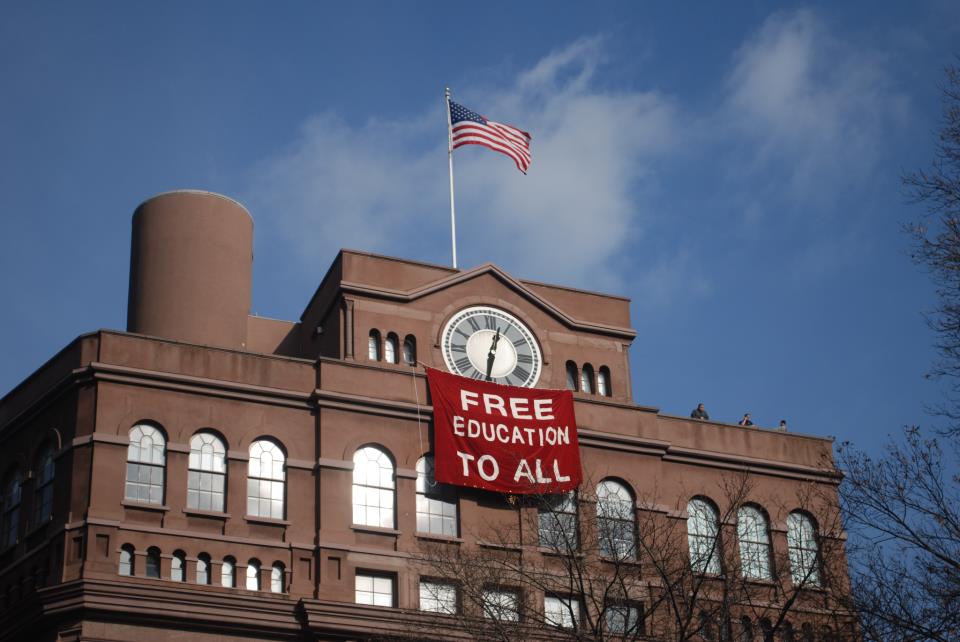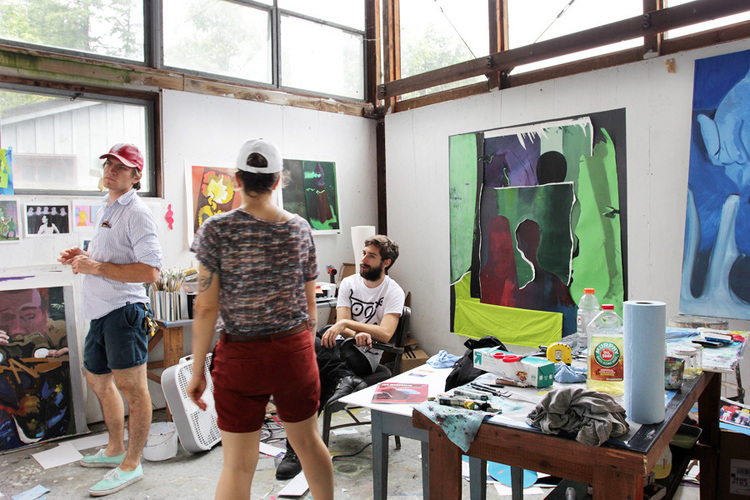Do You Have to Go to Art School to Be an Artist
Education isn't cheap. The increasing professionalization of the art world means getting a degree is an increasingly desirable path for many immature artists, but the levels of debt that come with the pursuit of knowledge makes this pick only viable for some. The question is: Can y'all become a successful artist without a degree from Yale or the Royal College of Fine art?
There are very good examples of successful contemporary artists who have side-stepped the academic route. Carsten Höller and Yoko Ono did not attend fine art school, Jeremy Deller studied fine art history rather than art, and Tosh Basco—aka boychild—started out in the underground society scene earlier working with their partner Wu Tsang and friend Korakrit Arunaanondchai. All these artists managed to embed themselves inside the networks of the fine art world. They exhibited. They spoke the linguistic communication.
American-Belgian artist Cecile B. Evans trained as a method player before entering the art world, and their unique perspective helped in the shift, says their gallerist, Emanuel Layr. "Cecile was restless in understanding the place of an artist," he explains. "It is exciting to meet them moving in between media—sometimes every bit a picture director."
Nonetheless, Layr is a supporter of an arts didactics—if you take the correct teachers. "I think it can be really cracking if there'due south a strong connection to a mentor or someone who actually gives you lot guidance in the start," he says. "But how many artists actually have such a great state of affairs with a professor?" And in many countries, art school is expensive. Amassing $fifty,000 in debt when you lot accept no guarantee of a chore at the end can exist a terrifying prospect. As Layr points out, committing to a career in the arts "nevertheless is a class question."

Students hang imprint below the historic clock tower at Cooper Union in New York City during a 2012 occupation protesting implementing tuition in the historically costless schoolhouse. Photograph by Free Cooper Union, Creative Commons Attribution-Share Alike 3.0 Unported license.
The high cost of art school became fifty-fifty more pronounced during the pandemic, when many art schools were unable to offer the usual elements of a degree course, like group critiques, studio fourth dimension or access to communal equipment—let alone the social interaction. "Students were very disempowered and disenfranchised past the lockdown and understandably really upset," says Peter Davies, a painter who shows with The Approach and teaches at the Slade School of Fine Fine art in London. "They were witting of being consumers and of having paid a very considerable amount in fees, but not getting the experience they were expecting. During lockdown, fine fine art courses weren't fifty-fifty able to provide studio space, with all activity existence online. This was hugely problematic."
Arguably, students' frustrations are a sign of a generational shift around the idea of arts didactics itself, with it being seen as a service being paid for rather than an investment towards future success that might not pay off rapidly. "The cost of living, and the cost now of academy education, ways many potential students who are besides potentially amazing artists are existence put off studying fine fine art, since it won't lead to a reasonable salaried job, in the way other university courses might."
Despite this, Davies is vocal near the importance of an education every bit a way to prepare young artists for the wider earth. And some recent Slade BFA graduates, such as Zeinab Saleh and Danielle Brathwaite-Shirley, already take strong institutional and gallery presences, despite not having a college degree, he says. In fact, many are foregoing postgraduate programs. Artists without MFA degrees, like Rhea Dillon, who studied fashion communications for her BA from Central Saint Martins art school in London, and Phoebe Collings-James, accept all found notable success.
Perhaps the biggest benefit of fine art schoolhouse might be the connections students brand there. Sebastian Lloyd Rees went to Goldsmiths for his BA, where he met Ali Eisa and formed Lloyd Corporation, an ongoing collaborative exercise making installation and performance art. Rees also works independently as a painter, which he started later completing his degree. "Knowledge is one of the biggest factors to development and to push yourself forrad. But is going to art school going to make you become an artist, when you graduate? Unfortunately not. I really don't remember and then," he says. "If I look back at Goldsmiths, as an institution, what it actually did for me was to start a collaboration."

Residents in the studio space at Skowhegan. Image courtesy of Skowhegan School of Painting and Sculpture.
Rees too offers some important questions those thinking about going to art schoolhouse should enquire earlier applying to a specific school: How many people are taking the form? How much time do you really get to speak to your tutor?
Equally the popularity of arts programs has grown over the past decade, a flurry of alternative art schools emerged, demonstrating the strong desire for an affordable arts teaching outside of the established institutional structures. Bruce High Quality Foundation notably ran a gratis schoolhouse in New York for a few years, with open lectures and workshops. Open School E in the United kingdom of great britain and northern ireland was established in 2013 every bit "an independent free art schoolhouse" with a focus on "emerging practitioners of different generations, with or without a BA, MA or formal qualification," according the application website. Alumni include the artists Lucy Beech and Paul Maheke Ngamaha.
Some other interesting alternative projection is the Academy of the Underground, established in 2017 and based between nightclubs in Amsterdam and London. Its founder, artist Nelly Ben Hayoun-Stépanian, describes the non-turn a profit as an advocacy network for complimentary creative and transnational education, where students work with established institutions from Deliveroo to the Un on a slate of collective performances, activist events and installation projects. "The core thought of the University of the Underground is the result or the feel as the starting betoken of a chat between nightlife creators and public institutions," she says.
The student body is made up of nightlife artists, sexual activity workers, poets, and other art schoolhouse graduates. "We try to invest as much every bit possible in young people, like age 21," she says. "They come from all different backgrounds—in general, I would say from underrepresented backgrounds, people that don't fit the normal bookish bill."
Hayoun-Stépanian, who has a PhD in human geography and political philosophy, is all the same aware of the importance of pedagogy on a CV. But she argues that in order for institutions like the education system to be decolonized, experimental approaches are necessary. "In order for mainstream education to evolve, a radical new model must accept place," she says.
The fundamental result at hand is what purpose an arts education is meant to serve. If you are looking for a return on a hefty investment in the form of a guaranteed flourishing career, and so arts school will probably disappoint you. Art schools could too exist seen equally a training ground where artists larn to produce the nearly appealing and saleable commodities for the market or institutional system, which is dominated by individual interests and cultural norms. Yet, you could as well view fine art schools as some of the last spaces where intellectual stimulus persists and other forms of thinking can emerge.
And then, fine art schoolhouse is either the terminal bastion of cultural resistance against capitalist ability—or a way of assimilating dissent into a readily consumable package. Either manner, yous tin discover success without it.
Follow Artnet News on Facebook:
Want to stay ahead of the art world? Subscribe to our newsletter to get the breaking news, eye-opening interviews, and incisive critical takes that drive the conversation forward.
Source: https://news.artnet.com/art-world/ask-experts-go-art-school-can-become-successful-artist-without-2034321
0 Response to "Do You Have to Go to Art School to Be an Artist"
Post a Comment